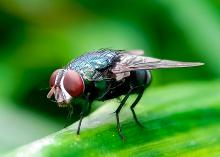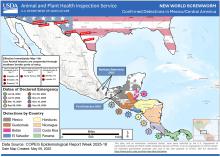Screwworm threat halts cattle imports from Mexico
STARKVILLE, Miss. -- In response to the continued expansion of screwworm flies into southern Mexico, the U.S. suspended live animal imports from Mexico on May 11, 2025, halting imports of feeder cattle from Mexico.
In the last 10 years, feeder cattle imports from Mexico averaged approximately 5% of U.S. feedlot placements. Feeder cattle imports from Mexico are seasonally highest in spring and fall, with as many as 20,000 head a week entering the country in normal years.
Since the southern border was reopened in February for cattle imports, additional inspection and quarantine regulations increased scrutiny and slowed the rate of cattle imports. Additionally, only four of the 11 ports of entry of cattle have been operating since early February.
Brandi Karisch, beef cattle specialist with the Mississippi State University Extension Service, said the border closing is a precaution to prevent the screwworm flies’ spread, and is part of procedures in place to prevent the pest from expanding into U.S. cattle.
“Cattle producers need to be prepared to understand what to look for in an infected animal, which is typically irritated behavior related to a wound, head shaking, biting at an open wound, the smell of tissue decay and maggots in the wound among other things,” Karisch said.
“Early symptoms can be difficult to see, but early detection, quarantine and reporting to a local veterinarian or Board of Animal Health official is highly important.”
Josh Maples, MSU Extension agricultural economist, said this latest border closure will likely affect beef prices, as the loss of feeder cattle imports will further shrink already tight feeder cattle supplies.
“Already record high calf prices will likely see some more upward pressure in the short term,” Maples said. “The inability to purchase these cattle will further pressure feedlots in the Southwest that are trying to source cattle from very tight supplies.”
Jerome Goddard, an MSU Extension professor of medical entomology, said the New World Screwworm approaching the U.S./Mexico border is a member of the blowfly family. Blowflies lay their eggs on dead animals, and the developing larvae, known as maggots, eat the dead carcass.
“The problem with this particular species of blowfly is that it lays its eggs on living animals and the larvae burrow into living flesh of cattle and other livestock, causing serious damage and sometimes death of the animal,” Goddard said.
The New World Screwworm fly is about the size of a housefly but is greenish-blue in color with golden yellow cheeks. Complicating matters is another blowfly common in the U.S. called the secondary screwworm fly that looks almost like the New World Screwworm, but it is harmless to people and animals.
“Screwworms used to be endemic in the entire southern half of the U.S., but they were eradicated in the 1960s to 1970s using the sterile male technique,” Goddard said. “This eradication process eliminated this pest from the U.S. all the way down to Central America.”
Despite the U.S. eradication, there are occasional introductions of the pests, and officials have to eliminate them again. Before the current screwworm fly threat, the most recent outbreak was in the Florida Keys in 2016.
“Since 2023, the New World Screwworm has been undergoing a rapid northward spread into Mexico, heading toward the U.S.,” Goddard said. “In response, on May 11, 2025, U.S. Secretary of Agriculture Brooke L. Rollins announced suspension of live cattle, horse, and bison imports through U.S. ports of entry along the southern border.
“The U.S. Department of Agriculture will continue to monitor this situation and implement prevention and eradication procedures where needed,” he said.
A variety of information from MSU Extension is available to beef cattle producers at . For more information about the threat of this specific pest, visit or .









